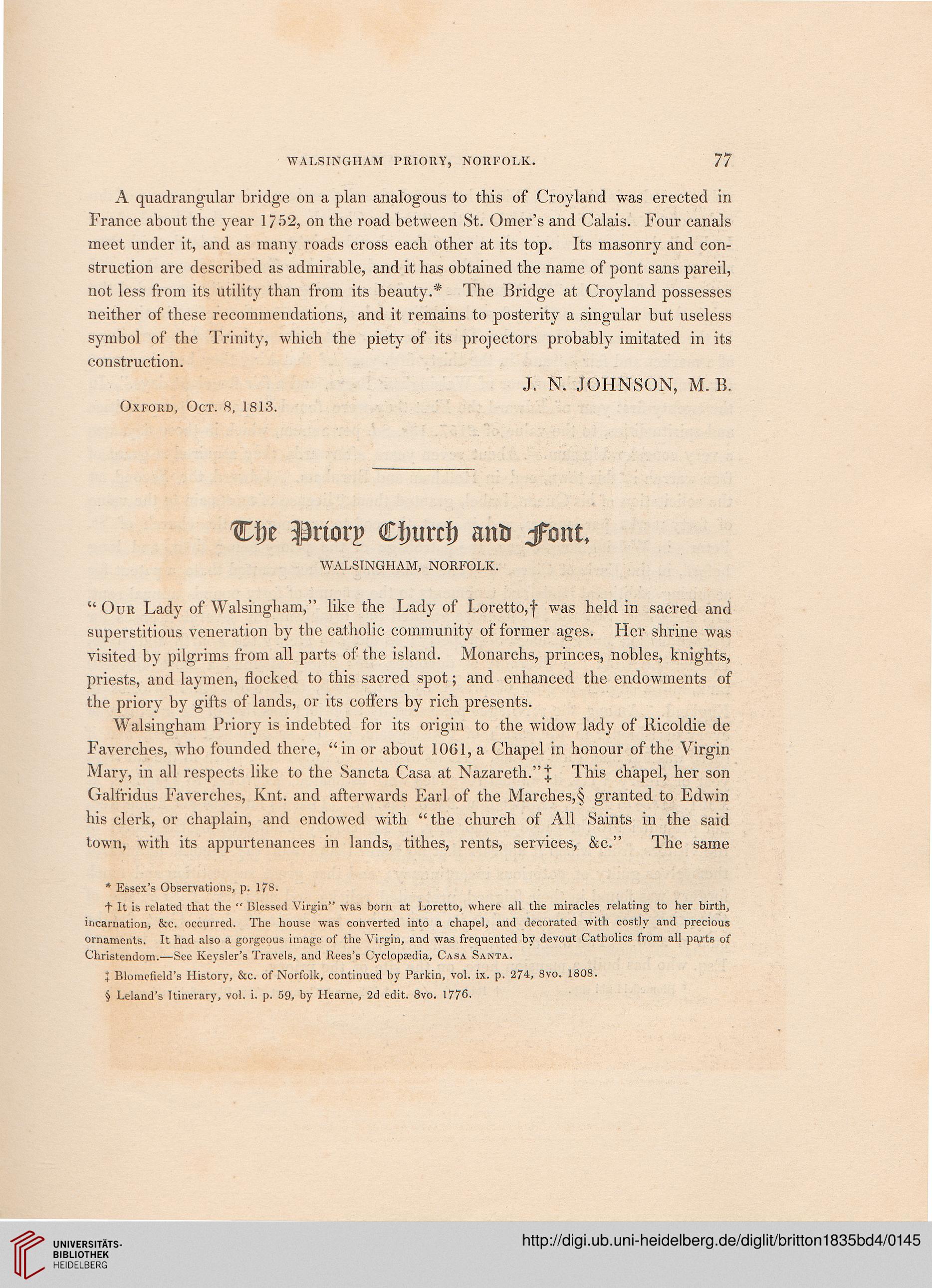WALSINGHAM PRIORY, NORFOLK.
77
A quadrangular bridge on a plan analogous to this of Croyland was erected in
France about the year 1752, on the road between St. Omer's and Calais. Four canals
meet under it, and as many roads cross each other at its top. Its masonry and con-
struction are described as admirable, and it has obtained the name of pont sans pareil,
not less from its utility than from its beauty.* The Bridge at Croyland possesses
neither of these recommendations, and it remains to posterity a singular but useless
symbol of the Trinity, which the piety of its projectors probably imitated in its
construction.
J. N. JOHNSON, M.B.
Oxford, Oct. 8, 1S13.
Cfje $rtorp Cinircf) anti jFont,
WALSINGHAM, NORFOLK.
"Our Lady of Walsingham," like the Lady of Loretto,f was held in sacred and
superstitious veneration by the catholic community of former ages. Her shrine was
visited by pilgrims from all parts of the island. Monarchs, princes, nobles, knights,
priests, and laymen, nocked to this sacred spot; and enhanced the endowments of
the priory by gifts of lands, or its coffers by rich presents.
Walsingham Priory is indebted for its origin to the widow lady of Ricoldie de
Faverches, who founded there, "in or about 1061, a Chapel in honour of the Virgin
Mary, in all respects like to the Sancta Casa at Nazareth." J This chapel, her son
Galfridus Faverches, Knt. and afterwards Earl of the Marches, § granted to Edwin
his clerk, or chaplain, and endowed with "the church of All Saints in the said
town, with its appurtenances in lands, tithes, rents, services, &c." The same
* Essex's Observations, p. 178.
t It is related that the " Blessed Virgin" was born at Loretto, where all the miracles relating to her birth,
incarnation, &c. occurred. The house was converted into a chapel, and decorated with costly and precious
ornaments. It had also a gorgeous image of the Virgin, and was frequented by devout Catholics from all parts of
Christendom.—See Keysler's Travels, and Rees's Cyclopaedia, Casa Santa.
t Blomefield's History, &c. of Norfolk, continued by Parkin, vol. ix. p. 274, 8vo. 1808.
§ Leland's Itinerary, vol. i. p. 59, by Hearne, 2d edit. 8vo. 1776.
77
A quadrangular bridge on a plan analogous to this of Croyland was erected in
France about the year 1752, on the road between St. Omer's and Calais. Four canals
meet under it, and as many roads cross each other at its top. Its masonry and con-
struction are described as admirable, and it has obtained the name of pont sans pareil,
not less from its utility than from its beauty.* The Bridge at Croyland possesses
neither of these recommendations, and it remains to posterity a singular but useless
symbol of the Trinity, which the piety of its projectors probably imitated in its
construction.
J. N. JOHNSON, M.B.
Oxford, Oct. 8, 1S13.
Cfje $rtorp Cinircf) anti jFont,
WALSINGHAM, NORFOLK.
"Our Lady of Walsingham," like the Lady of Loretto,f was held in sacred and
superstitious veneration by the catholic community of former ages. Her shrine was
visited by pilgrims from all parts of the island. Monarchs, princes, nobles, knights,
priests, and laymen, nocked to this sacred spot; and enhanced the endowments of
the priory by gifts of lands, or its coffers by rich presents.
Walsingham Priory is indebted for its origin to the widow lady of Ricoldie de
Faverches, who founded there, "in or about 1061, a Chapel in honour of the Virgin
Mary, in all respects like to the Sancta Casa at Nazareth." J This chapel, her son
Galfridus Faverches, Knt. and afterwards Earl of the Marches, § granted to Edwin
his clerk, or chaplain, and endowed with "the church of All Saints in the said
town, with its appurtenances in lands, tithes, rents, services, &c." The same
* Essex's Observations, p. 178.
t It is related that the " Blessed Virgin" was born at Loretto, where all the miracles relating to her birth,
incarnation, &c. occurred. The house was converted into a chapel, and decorated with costly and precious
ornaments. It had also a gorgeous image of the Virgin, and was frequented by devout Catholics from all parts of
Christendom.—See Keysler's Travels, and Rees's Cyclopaedia, Casa Santa.
t Blomefield's History, &c. of Norfolk, continued by Parkin, vol. ix. p. 274, 8vo. 1808.
§ Leland's Itinerary, vol. i. p. 59, by Hearne, 2d edit. 8vo. 1776.




